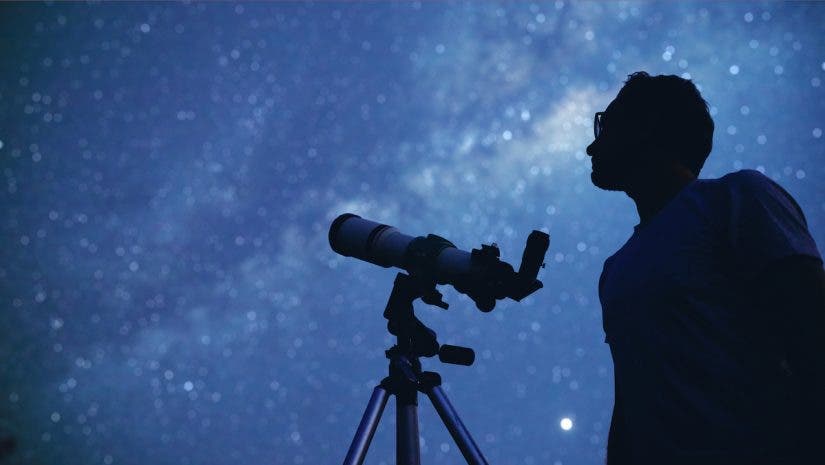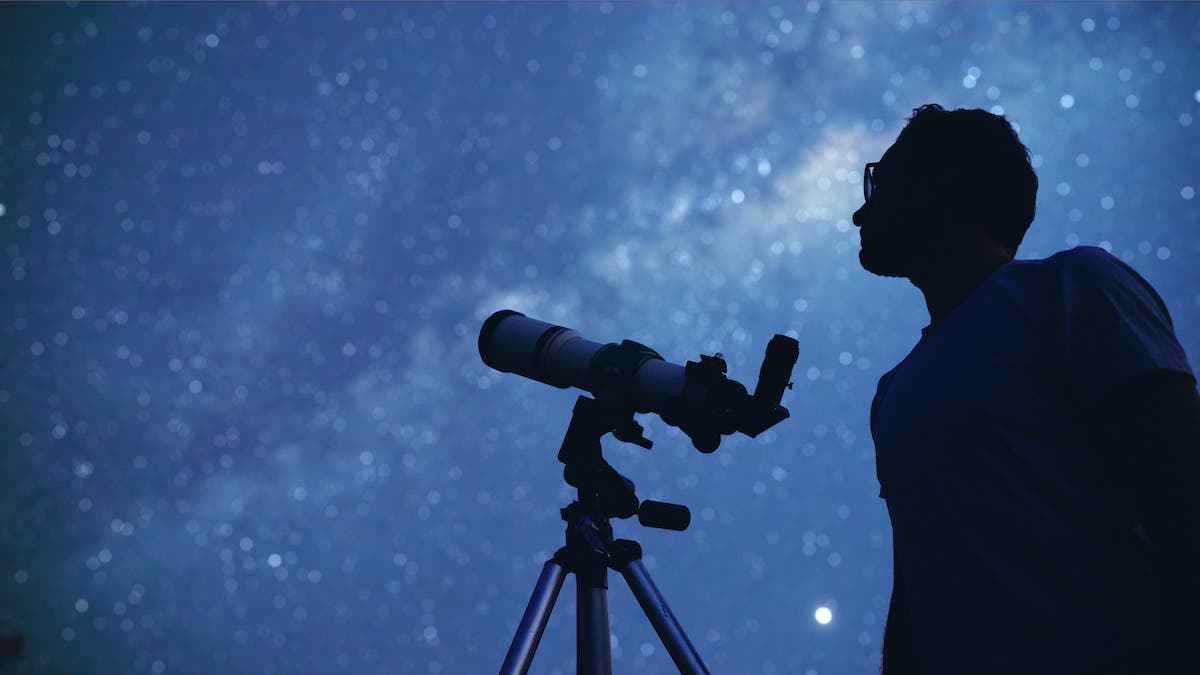For those taking their first steps into the world of stargazing, choosing the right telescope can make all the difference. In this guide, we share a curated selection of the best telescopes tailored to beginners to give aspiring astronomers the tools they need. Whether you want to view the upcoming eclipse, shimmering stars, distant planets, or nebulae, you’ll have a path to discover the cosmos with these best telescopes for beginners.
What to Look for in a Telescope
Aperture
One of the most important features of a beginner telescope is the aperture. A telescope with a larger aperture allows more light into the telescope. This, in turn, will give you better viewing options for darker objects in the sky. The aperture isn’t too important if you only hope to see bright objects like the moon and sun. Although, for deep-space viewing, you’ll need a wider aperture.
Size
Convenience and size are other features to consider when picking out a telescope. Unfortunately, telescopes with a wider aperture are generally much larger. Finding the right balance between telescope size and aperture for your preferred viewing is important.
Magnification
Another feature commonly advertised is magnification. The more magnification you have, the easier it will be to see objects that are very far away. Finding the right balance between a large aperture and a high magnification is crucial if you want to view dim objects that are very far away.
Mount
The last thing to consider is the type of mount. Telescopes come in two different kinds of mount – altitude-azimuth and equatorial. Altitude-azimuth mounts, otherwise known as alt-az, are best used for viewing and are much simpler for beginners. However, if photography is your goal, you’ll want to go with an equatorial mount, which allows you to track a singular object for hours in the night sky.
Types of Telescopes
Refractor
A refractor telescope utilizes a lens to produce an image. These telescopes are usually low-maintenance but may be more expensive than other kinds. Generally speaking, refractor telescopes are bigger and heavier than similar-aperture reflectors and catadioptric telescopes.
Reflector
Reflector telescopes utilize a mirror to produce an image, and they may offer the best bang for your buck compared to other kinds of telescopes. The downside to reflector telescopes is that the mirror can get out of alignment easily, meaning you’ll have to adjust to realign the telescope.
Catadioptric
A catadioptric telescope uses both lenses and mirrors to produce images. Because of this, it may be more expensive than other kinds of telescopes. This design allows more magnification in a telescope that is usually more compact. Catadioptric telescopes also give a wider field of view for their size, which is perfect for those who wish to view large objects like galaxies.
Best Telescopes for Beginners
Vaonis Hestia Smart Telescope
Why We Chose This Telescope: The Vaonis Hestia Smart Telescope is a smartphone-based telescope that lets you capture the sheer brilliance of celestial bodies without a complex or expensive setup.
- Telescope Type: Reflector
- Aperture: 1.2” (30mm)
- Mount: Tripod
Vaonis Hestia is the first ever telescope that utilizes a wide list of smartphones whether iPhone or Android – allowing even casual photographers to take pictures of the Sun, Moon, and the Universe. Hook your phone up to the Vaonis Hestia Telescope’s ocular and choose the celestial object that you want to capture just by tapping a few buttons in Hestia’s app: Gravity by Vaonis.
The app is rich with features such as advanced proprietary image processing algorithms that take multiple short-exposure images and combine or align them together, to create a single high-quality jaw-dropping photograph. Additionally, you can check out weather conditions in your area before going out for a shoot with Gravity’s in-tune weather updates. With both these features and more, you’re well-equipped to get out there and enjoy every chance to stargaze and see the wonders of sky photography and astrophotography.
Celestron PowerSeeker 127EQ Telescope
Why We Chose This Telescope: This is a great beginner-level telescope perfect for first-time users who want to enjoy space viewing with minimal setup.
- Telescope Type: Reflector
- Aperture: 5” (127mm)
- Mount: Equatorial Head
The Celestron PowerSeeker 127EQ Telescope is an amazing beginner telescope that is easy to set up. This telescope doesn’t break the bank, and it is perfectly sized for any beginner looking to dip their feet into space viewing. This telescope comes with equatorial mounts that are perfect for tracking, as well as collapsible alt-azimuth mounts that can be used for terrestrial viewing. Also included are multiple eyepieces and a 3x Barlow lens that gives you an image hundreds of times greater than the unaided human eye.
The PowerSeeker is made using fully coated glass and high transmission coatings. This offers excellent brightness and clarity which are incredibly important for night-sky viewing and shooting. Slow-motion controls allow smooth tracking, and the telescope even comes with 2x slow-motion cables. The included tripod is adjustable in height, allowing you to set up the telescope for optimal viewing perfectly. You’ll also get an accessory tray for convenient storage of all of the many included accessories to use with the telescope.
If you need a beginner telescope for terrestrial and astronomical use, the Celestron PowerSeeker 127EQ is an excellent choice for the whole family to enjoy space.
Celestron AstroMaster LT 70AZ 70mm f/10 Refractor Telescope
Why We Chose This Telescope: This telescope has a quick and easy to set up that is ideal for viewing planets and moons.
- Telescope Type: Refractor
- Aperture: 2.75” (70mm)
- Mount: Alt-Az
If you’re after bright and clear images of the moon and other planets, the Celestron AstroMaster LT 70AZ Refractor Telescope may be just what you need. This telescope is portable and easy to assemble, and the alt-az mount gives you great control with a smooth clutch that offers accurate pointing. A StarPointer Red-Dot Finderscope makes it easy to point the telescope directly at your target for easy setup, and coated glass optics ensure clear and crisp images.
In addition to the telescope, you’ll also get an optical tube, tripod, and mount, 10mm and 20mm eyepieces, the StarPointer, and an Erect Image 90 Degree Diagonal. The telescope comes with a deluxe accessory tray to hold all of your accessories for quick and easy access in the dark.
This is the perfect telescope to view things like the belts and moons of Jupiter, or the rings of Saturn. However, if you’re looking for brighter deep space objects like galaxies and nebulae, you’ll need to look for a more advanced telescope.
Celestron StarSense Explorer DX 5″ Schmidt-Cassegrain
Why We Chose This Telescope: It’s a cosmic GPS that fits in a satchel. To use it, just pop in your phone, and boom! You can freely navigate the night sky.
- Telescope Type: Schmidt-Cassegrain
- Aperture: 5″ (127mm)
- Mount: Altazimuth with slow-motion controls
This telescope is an easy and frustration-free way to find celestial objects. The StarSense Explorer app makes your smartphone an intuitive star-finding system. Therefore, it guides you to planets, nebulae, and galaxies with minimal effort.
The optics are top-tier, too! With StarBright XLT coatings, brightness and contrast is significantly boosted. So, yeah, you won’t just be staring into a dim abyss.
Additionally, its altazimuth mount with slow-motion controls means you can smoothly track objects as they drift across the sky. Trust me, once you lock onto Saturn’s rings, you won’t want to lose sight of them.
Sky-Watcher EvoStar 100ED / ProED 100 100mm ED Refractor Optical Tube
Why We Chose This Telescope: Because with this tube, you get crystal-clear and color-pure views of the cosmos.
- Telescope Type: Refracting
- Aperture: 4” (100mm)
- Mount: Sold separately
This is an apochromatic ED refractor that uses FPL-53 extra-low dispersion glass. So, it reduces chromatic aberration to nearly nonexistent levels. Isn’t that so cool?! With this beginner-friendly telescope, you can clearly see the Moon, planets, and even deep-sky objects in their true color.
It has a 2-inch Crayford-style dual-speed focuser that allows you to make ultra-fine focusing adjustments. Oh, and let’s not forget style. This thing looks as good as it performs. The sleek, aluminum optical tube with a glossy black and gold fleck finish makes it clear: this is a telescope for observers who appreciate both function and flair.
Barska 300 Power Starwatcher 70mm Refractor Telescope
Why We Chose This Telescope: This kit is everything an entry-level astronomer needs, and it’s easy to set up with all of the necessary accessories.
- Telescope Type: Refractor
- Aperture: 2.75” (70mm)
- Mount: Pan-Head
The Barska 300 Power Starwatcher 70mm Refractor Telescope is easy to set up and it comes with all of the basic accessories for optimal celestial viewing. Accessories include a finderscope, 2 interchangeable eyepieces, a 3x Barlow lens, pan head mount, 45-degree erect image diagonal, table-top tripod, carrying case, and the beginner’s version of Barska’s Deepsky Astronomy Software (compatible with Windows 95, XP, and Vista only). The software has a database covering over 10,000 objects — all of which you can find and view in the sky.
For users who have a poor back or neck, the 45-degree diagonal will save you both neck and eye strain by bringing the scope right up to your face without having to bend down too far. A 2×24 finderscope makes it easier to find an object in the sky, and the 3x Barlow lens gives increased levels of magnification. The two 1.25” eyepieces (K20 20mm and SR4 4mm) combine with the 3x Barlow to give magnification power of 60 and 300. This allows you to see further when combined with the 2.75” aperture of the Barska 300 Starwatcher.
ExploreOne Aurora 19-52×114 Alt/Azimuth Slow Motion Mounting Telescope
Why We Chose This Telescope: A substantial aperture for its price point makes this telescope stand out against other similar scopes on the market.
- Telescope Type: Reflector
- Aperture: 4.5” (114mm)
- Mount: Alt-Az Slow Motion
The ExploreOne Aurora 19-52×114 Telescope offers one of the largest apertures for its price point. This makes it an excellent choice for beginners who wish to view some of the darker objects in the sky. A focal length of 1100mm combined with two premium Plossl eyepieces allow viewers to see galaxies, nebulae, and star clusters that couldn’t be seen on a scope with a smaller aperture. The ExploreOne 19-52×114 features superior options combined with a sturdy mount and very smooth motion controls to give the user well-defined images that should satisfy any beginner.
Included with the telescope, buyers will also get the metal tripod, red dot finder, CR2032 battery, and astronomy software. For beginners looking for optimal viewing of deep space objects, look no further than the ExploreOne Aurora 19-52×114 Telescope.
Conclusion
Picking out the best telescope for beginners might seem like a daunting task, and the best telescope is truly going to depend on your desired usage. Most importantly, try to find a beginner telescope that is easy to use and will help you practice and enjoy the night sky.
FAQ: Best Telescopes for Beginners in 2025
A beginner should go for either a refractor or a reflector telescope. Refractors are low maintenance and great for planetary views, while reflectors offer more bang for your buck in terms of aperture.
When it comes to seeing planets, go for an aperture of at least 70mm. If you want to see Jupiter’s moons, Saturn’s rings, or Mars’ polar caps in detail, go for 100mm or more.
A refractor telescope with a long focal length or a catadioptric telescope (like a Schmidt-Cassegrain) will give you the sharpest planetary views.
A solid beginner telescope will cost anywhere from $150 to $500. The lower end will get you a decent entry-level refractor for moon and planet viewing, while the higher end gets you larger reflectors or catadioptric models for deep-space wonders.






